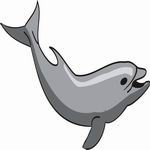- A group of porpoise is called a Pod
- Their snouts, or beaks, are called the Rostrum
- The Fatty tissue below a porpoises's skin helps to keep it warm and
is called Blubber
- Fins - the Pectoral Fins are used for stopping and steering and found
on either side of the body
- Fins - the Flukes are used for propelling through water and are located
on the tail
- Tubercles - Where the porpoise has no dorsal fin on its back it has
a small ridge beginning just back from the blowhole and extending to
the tail flukes; this ridge is covered in small circular bumps known
as tubercles
- a hole at the top of a porpoise's head called a Blowhole which is
used for breathing and making sounds
- Porpoises are 4 to 6 ft (120-180 cm) long and are black above and
white below.
- The fat of the porpoise yields a lubricating oil, and the flesh is
sometimes eaten.
- All porpoises can see, however as visibility is restricted underwater
they have developed the use of a sonar system called 'echolocation'
to find food when navigating and hunting for food.
- Their clicks make high-frequency sounds, and the echoes of these sounds
bounce back which enables them to make a mental map. Using this mental
map they are able to avoid the smallest of obstacles whilst locating
their prey.
- In just a split second Echlocation enables them to determine the size
of objects, their location, how fast they are
- There are six different species of Porpoise:
- Porpoise are native to Indian, Atlantic and Pacific Oceans.
- The common habitat is in oceans, shallow waters and estuaries
- The diet of Porpoise consist of fish, shrimp, prawns, octopus and
squid
|


